Greenwich & Woolwich foot tunnel cyclists to get partial green light
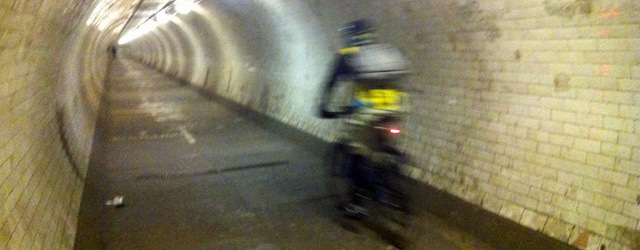
Greenwich Council is to trial “shared use” of the Greenwich and Woolwich foot tunnels, which will mean cyclists being officially allowed to use them at quieter times, it has emerged.
The council’s put in a bid for £100,000 of City Hall money to develop technology to record pedestrian and cyclist movements in the tunnel, to warn cyclists when the narrow passages make it unsafe for riding.
The Friends of Greenwich and Woolwich Foot Tunnels have been asked to act as partners on the bid, along with Tower Hamlets and Newham councils.
Fogwoft says: “The proposal would allow shared use between pedestrians and cyclists at times when the tunnel is fairly empty. It would require cyclists to walk when necessary. It would allow them to cycle when safe.”

Any proposal to allow cycling in the tunnels will be a hugely contentious issue – while there is a blanket ban on riding bicycles, it is widely flouted, especially in the Greenwich tunnel, which is a major link for cyclists between south-east London and Canary Wharf. Since lift attendants were withdrawn some years ago, there has been little enforcement of the ban.
If Greenwich’s bid to City Hall is unsuccessful, the council says it will fund the scheme itself.
The council says: “The proposal will be to use state of the art technology to trial shared use in the tunnel. It will monitor cycle and pedestrian flows (and cycle speeds) at all times, and use this to regulate the cycling ban; at times of low pedestrian flow, considerate cycle use will be permitted, and conversely during high pedestrian flow periods cyclists will be required to dismount and push through the space. In other words, the permission levels would respond in a timely manner to conditions in the tunnels at all times.
“This will be enforced through clear, digital signage triggered by the flow levels during each period, which will be tracked throughout the tunnel. The visual signage could be backed up by audible messages, and reinforced through additional monitoring via CCTV and other means.
“Technology will also be used to monitor the speed of any person cycling through the tunnel, flashing up clear signage to anyone travelling quicker than a recommended limit (to be defined) in a similar way to speed warning signs used on highways.”
The bid document says a trial would last for 12 months and be “rigorously monitored”.
“In using digital technology to track, monitor and regulate permissions at various times of the day, users will feel that a sensible use of the space is allowed at all times. If successful, the trial has potential to be extended to other similar spaces throughout London,” it adds.
A further £10,000-£25,000 would fund “behavioural change” measures – enforcement, in other words.
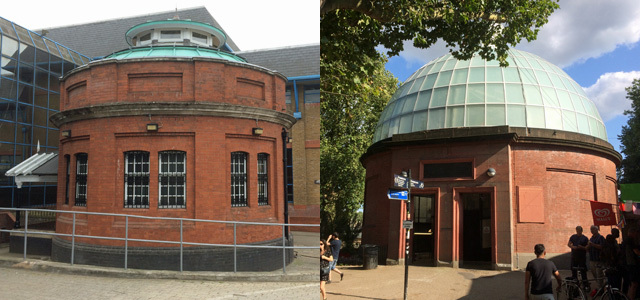
500+ people per day use the Woolwich tunnel, over 3,000 use the Greenwich tunnel
It’s believed that a system would be trialled in the quieter Woolwich tunnel before being moved to Greenwich by 2016/17.
Fogwoft has invited users to discuss the issue at its annual general meeting on 2 October. (See more on Fogwoft’s website.) The council will also have to consult the public directly about the scheme, which will involve a change to a by-law.

The announcement comes as the long-delayed refurbishment works on both tunnels enter their final stages, after long delays caused by poor management of the project, both by the council and contractor Hyder Consulting.

While deep cleaning hasn’t taken place, the lifts at Woolwich are now working, though anecdotal evidence suggests the Greenwich lifts are still bedevilled by breakdowns. Indicators have been placed in the Greenwich tunnel to warn of lift problems, although they are difficult to read in sunlight.
In December 2012, a poll on this website showed 51% of voters would back cycling in the tunnel at all times, with just 16% favouring the current ban and 18% backing the kind of compromise Greenwich is going for. This may indicate something about the readership of this website, though.
But with Greenwich Council backing the motor vehicle-only Silvertown Tunnel, and with even more intensive development planned for the Isle of Dogs, the foot tunnel issue shows it’s clear there is still a massive, unmet demand for safe pedestrian and cyclist crossings from south-east to east London.
Monday update: Here’s an interesting project – the echoey sounds of the Woolwich Foot Tunnel captured in Waves of Woolwich.
Cycling in Greenwich borough: Two steps forward, one step back
It’s the simplest things that make cycling easier – and safer. Until recently, the single greatest improvement to my pedalling life was Lewisham Council resurfacing the main road out of Blackheath Village. Prince of Wales Road was treacherous, potholed, and grim. Now it’s like velvet. No more uncertain bouncing around, no more swerving around great dents or slowing down to absorb the bumps. Safer, and with fewer surprises for drivers. (Other areas of Lewisham borough haven’t been so lucky, mind.)
Together with Greenwich Council putting down a new surface at Blackheath Standard, it’s made a kilometre-long stretch a simple ride.
New cycle lanes on Charlton Road as well as Woolwich Road and Trafalgar Road have helped too. They’re not perfect, the deathtrap that is the Woolwich Road flyover is still being swerved while more radical ideas like redesigning side streets are being ignored. And the less said of the leadership’s road-building policies, the better. But they’re encouraging moves in the right direction.

Greenwich Council’s done some more super, simple cycling things recently. Nearly four years ago, I grumbled about the 1990s cobbles that interrupted the Thames Path at Greenwich Millennium Village. A couple of months back, they were finally sorted.
Now, all they need to do is indicate the pedestrian and cycling sides of the path a bit more clearly, and it’ll be nearly perfect (which is more than you can say for pedestrian and cycling provision in the rest of GMV).

Back up in Charlton, the wider cycle lane was blighted by a dangerous build-out into the road at the Charlton Road/Wyndcliff Road junction, just as you approach a zebra crossing.
Build-outs – where the pavement juts into the road – are a 1990s thing. But with cyclists encouraged to ride on the left of the road, this can bring bikes into conflict with motor vehicles – particularly as many drivers have an unfortunate habit of trying to race you to a point where the road narrows. One – to assert the primacy of buses on the A206 – was removed from a bus stop on Woolwich Road when the new cycle lanes were put in last year.
Now, the Charlton Road horror has been fixed – though it could do with resurfacing – and the street is much safer.
So, at least in the north-west of the borough, some positive’s action’s being taken to make cycling safer. Sadly, though – the reverse is happening in the deep south. Head out to Eltham, go down Avery Hill Road – a hairy stretch treated as a racetrack by many drivers – and you’ll find a brand new build-out…

From what I can gather, it’s to make it easier for Greenwich University students to cross the road after they’ve taken the 286 bus to their Avery Hill campus. But the first time I came across this, I found myself with a speeding berk bearing down on me as I moved to avoid this new obstruction in the road.
It’s not safe, and considering the good work being done in the north of the borough, it’s baffling as to why this would be installed in the south.
But it’d be churlish to ignore the good work that’s being done in areas like Greenwich, Charlton and Blackheath. If Greenwich Council really wants to encourage cycling – and there is a strategy now in place – then it needs to be consistent across the borough, and its highways engineers need to checking their “improvements” against this, rather than going for the first solution they can think of.
Metroknobbers: New Greenwich blogs, and sex and the SLP
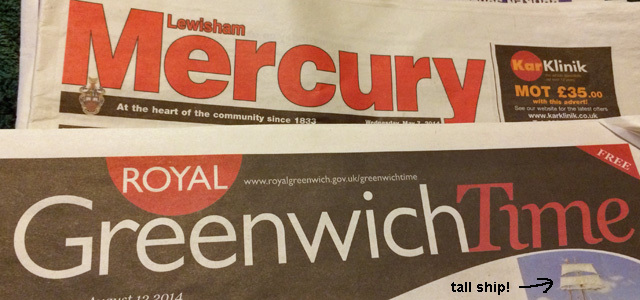
Bored this damp bank holiday? Be entertained by Jason Cobb and myself talking about the kind of stuff you’ll find on this site and on Onionbagblog/ Brixton Buzz – local politics, hyperlocal publishing and south London. Features new Greenwich-area blogs Promises and Pie and Boy and Girl Meet Pub, plus another mention for the fantastic Deserter blog and its Great Train Journeys: London Bridge to Charing Cross.
There’s a full list of links over at Onionbagblog.
Berkeley Homes and Boris Johnson’s £500 ceremonial trowel

There’s an interesting feature in this week’s Economist about Berkeley Homes, the developer which had a great influence on Greenwich Council during the Chris Roberts years.
It’s not just interesting because it features “a local blogger” commenting on the former Dear Leader, who’s still in close contact with the council leadership, and his ownership of a Berkeley home on the Royal Arsenal development in Woolwich. It also features the revelation that Boris Johnson was given a £500 ceremonial trowel by Berkeley’s chairman, Tony Pidgeley, last summer. (He was also given a glass paperweight in October.) Johnson is, of course, responsible for strategic planning approval for developments such as the Arsenal (which is GLA land) and Kidbrooke Village. (Mind you, at least you can find Johnson’s gifts and hospitality on the City Hall website – try having a look for the equivalent on the Greenwich site.)
It’s not just Berkeley, it’s not just Greenwich, it’s not just Boris Johnson. Developers’ demands are weighing heavily on many London boroughs, but some are more eager to be associated with them than others. And Berkeley’s particularly good at gaining influence, especially as Pidgeley is also president of the London Chamber of Commerce and Industry (chair: Chris Roberts’ friend Mark Adams) which has been pushing heavily for the Silvertown Tunnel and Gallions Reach Bridge. Indeed, this written answer from Johnson to London Assembly member Caroline Pidgeon acknowledges the link between Berkeley and the LCCI.
Next month’s tall ships boondoggle will also feature another example of a developer wielding financial power – Barratt Homes, which is currently letting historic Enderby House rot away, is sponsoring the event and has its name on banners in Greenwich town centre. “Festival supporters” include Berkeley, Cathedral Group (Silvertown Tunnel supporter and Morden Wharf developer) and Knight Dragon (Greenwich Peninsula developer). Lots of lovely hospitality, no doubt.
It’s not just on tall ships where developers and councillors can get together. Earlier this summer Cathedral’s chief executive Richard Upton popped up at the unveiling of a tree dedicated to Vice Admiral Hardy at Devonport House, Greenwich, alongside Greenwich leader Denise Hyland and Lewisham’s deputy mayor Alan Smith. Cathedral owns Devonport House, alongside the Movement development by Greenwich station and the Deptford Project across the borough boundary. Naturally, it got a warm write-up in Greenwich Time.
So it’s worth keeping an eye on little things like this. As developers become more powerful, and with councils often unable to build their own housing, do we have representatives that can resist these charm offensives and fight for a good deal for us all?
Incidentally, the picture above is that of an ad for the latest phase of the Royal Arsenal – effectively, the flats that’ll pay for Berkeley’s contribution to the Crossrail station there. Note the little back-scratch for the mayor in the shape of a New Routemaster cruising along Beresford Street – in reality, it’s highly unlikely that the Roastmaster will ever make it to SE18.
Revealed: Mercury owner’s bid to take over Greenwich Time

Greenwich Council refused an approach from the owner of the Mercury and South London Press newspapers to take over its controversial weekly freesheet Greenwich Time, it’s emerged – and is being accused of misleading its own councillors about the offer.
The offer, made three years ago, is at the centre of a row between the publisher and the council over figures used by Greenwich leader Denise Hyland to justify continuing with the newspaper, one of only two in the country that are published weekly.
It comes as Greenwich Council is defending the paper against new laws brought in by the coalition government, with communities secretary Eric Pickles calling it “propaganda on the rates”.
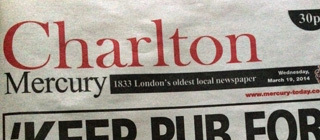 Before GT went weekly, it had a long-standing distribution arrangement with the Mercury, which is London’s oldest local paper and is run as a sister paper to its Tindle Newspapers stablemate, the South London Press.
Before GT went weekly, it had a long-standing distribution arrangement with the Mercury, which is London’s oldest local paper and is run as a sister paper to its Tindle Newspapers stablemate, the South London Press.
Greenwich claims it saves money by publishing GT weekly as it can place public notices – for planning, road closures, and the like – there without having to pay a third party for advertising.
But a letter from SLP managing director Peter Edwards to Hyland, sent earlier this month, claims the council presented “inaccurate data” when justifying this in a council debate in June, which saw councillors vote down an anti-GT motion from the Conservatives.

Greenwich claimed advertising in the Mercury would cost it £1.37m per year – but Edwards says he told council officers in a presentation that the council would only pay 55% of that sum, while the Mercury would also increase its distribution to 90% of the borough.
“We would also establish a channel on the Mercury website to carry notices, online videos and interviews, plus video streaming of open council meetings, all of this within the price quoted,” he added.

“In short, we would ensure every Greenwich resident had full and unfettered access to council messages.
“I am certain that if your meeting on 25th June were in full possession of all the facts it may have reached a different conclusion.”

In response, Hyland claims councillors already had “access to the full range of information you have provided”. But this information was only shared with cabinet members at the time, and not with the full council. While the council admitted in July 2011 that talks had been held with publishers, the details were not shared beyond the cabinet.
She added that the SLP/Mercury package would have “cost the council more for less” and would have still resulted “in an increase in expenditure”.

In addition, Hyland said the SLP’s offer would not have matched GT’s distribution, and could leave the council open to “a potential reputational risk as our adverts may appear alongside those for adult service providers and chat lines”.
(The sex trade ads are an Achilles heel for the SLP when it comes to dealing with local councils – some years ago, Lambeth withdrew its ads from the SLP in protest. After a spell running a GT-style fortnightly, Lambeth Life, Lambeth took its ads to an independent, Southwark Newspaper, which now produces a weekly Lambeth Weekender featuring four pages of council news plus public notices.)
After the Mercury/SLP offer was rebuffed in 2011, Tindle Newspapers took on a different strategy to push the Mercury, de-emphasising free deliveries in Greenwich borough in favour of creating paid-for micro-editions on sale in newsagents in west Greenwich, Charlton and Blackheath – the first paid-for papers to serve the areas for three decades.

More recently, Greenwich Council has come out fighting to defend Greenwich Time, which the Government believes it has now outlawed.
“I do not understand on what basis the Secretary of State considers that the council’s publicity is not even-handed or objective,” chief executive Mary Ney, whose job is supposed to be politically-neutral, wrote on 29 April in response to a warning from Pickles that he was considering action.
“This is a serious allegation and I am entitled to understand on what basis it is being made.”

Greenwich Council’s full response, obtained by this website under the Freedom of Information Act, lays into critics of Greenwich Time, essentially implying they do not represent the views of the people of the borough as “half are active in local politics”. “The objectiveness of their submissions has to be questioned,” it adds.
If Greenwich Time is axed, it claims, it will be “on the decision of a single minister, based upon the representations of 8 people out of a borough population of 264,000″.
It also claims that Greenwich Time supports the local newspaper industry as it is printed at Trinity Mirror’s presses in Watford, that Greenwich borough has “a strong local newspaper market”, and that it has “given extensive coverage to the Mayor of London”, and lists the (rare) occasions that opposition councillors are featured in it.
But it misses out the fact that its “rigorous sign-off process” includes the sign-off from the council leader, as admitted by Mary Ney last year, while the council’s sums still don’t take into account the time council staff spend on Greenwich Time.
 The council’s response also included a dossier of notes of support from various figures, including a bizarre letter from someone at the Greenwich Islamic Centre in Plumstead which hopes the Government will change its mind so “the residents of the borough can enjoy their favourite weekly newspaper”.
The council’s response also included a dossier of notes of support from various figures, including a bizarre letter from someone at the Greenwich Islamic Centre in Plumstead which hopes the Government will change its mind so “the residents of the borough can enjoy their favourite weekly newspaper”.
Another respondent claims “it is a very balanced publication which does not demonstrate political bias in any way”, while the council response quotes another individual as claiming it runs “fact-based community editorial”.
One response backing GT comes from Steve Nelson of the South East London Chamber of Commerce, who’s regularly invited to the council’s mayor-making jollies at the Royal Naval College and is a trustee of council charity Greenwich Starting Blocks, which features regularly in the paper.
Looking through the responses, with names redacted, it seems that those who appear in Greenwich Time support it, and those who don’t are against it.
Which, in a nutshell, is the problem with Greenwich Time. Just as the Evening Standard has ceased to be a reliable news source because it contains little criticism of mayor Boris Johnson, Greenwich Time is similarly unreliable because it contains little criticism of Greenwich Council. And only one of those two titles is paid for by council taxpayers.
Whatever the failings of this area’s local media, the fact that we’re paying for a weekly paper which delivers just one side of the story is a big problem. And after six years of it, it’s far from certain that a weekly propaganda rag is even an effective communication strategy for the council anyway – how many go straight in the recycling? Simply barking out instructions on a dead bit of tree simply doesn’t cut it these days.
If Greenwich Time goes, the council’s communications and engagement policy will have to be rethought. And a deal with someone will have to be done, be it with the Mercury/SLP or a competitor, for those public notices.
Like alcoholics contemplating a future off the booze, a future without Greenwich Time is one the council leadership simply doesn’t want to contemplate.
Will Eric Pickles take the bottle off them? We’ll have to wait and see.
Blur’s Parklife on the Greenwich Peninsula: 20 years on

It’s 20 years ago today that Blur’s video for Parklife was shot outside the Pilot pub on the Greenwich Peninsula. Directed by Pedro Romhanyi – who’d later shoot the promo for Pulp’s Common People – it remains one of the most fondly-remembered of all British music videos.
I remember it well – the filming took place on my 20th birthday. After hearing Blur were filming on the peninsula, I walked up to take a look. Of course, what I didn’t take was my camera.
If anyone has any memories of the filming – or photographs – I’d love to hear them, along with any corrections to anything I’ve got wrong. (Here are some production shots along with some other Blur snaps from the time.)
It was filmed over two days – 8 and 9 August, 1994 – with most shooting taking place in River Way, a street containing the Pilot pub, some cottages, an industrial estate and the remains of the old Blackwall Point Power Station. In those days, if you travelled up Blackwall Lane onto the Greenwich Peninsula, River Way was a turning on the right before Blackwall Lane ended at the junction of Boord Street and the gates to the old gas works. It was a dead end, leading up to the Thames and the original base of Greenwich Yacht Club.
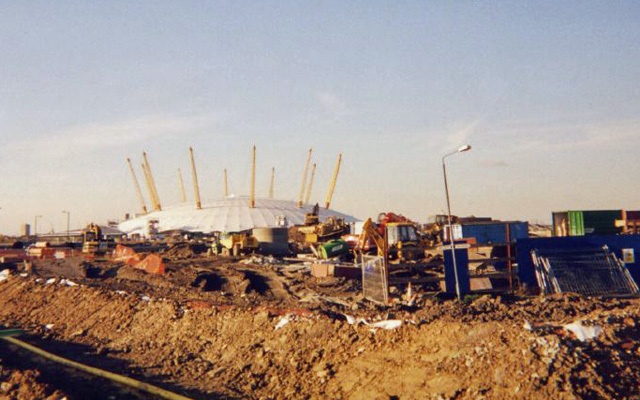
River Way from Blackwall Lane, taken in autumn 1998. The Pilot would have been out of shot on the right, I think.

River Way, some time in 1998 – the Pilot would be on the left.
River Way’s days were numbered, though. Less than two years later, the Greenwich Peninsula was chosen as the site for the Millennium Experience. Two years after that, the street was gone, although the pub and the cottages remain. Remarkably, the Pilot’s landlord resisted offers to sell the place until well into the 21st century – it’s now owned by Fullers and was refurbished last year.
The Pilot’s not marking the anniversary of its little entry into British pop history – it’s staging Shakespeare in its beer garden instead.

Left and centre: The Thames-side end of River Way, spring 1998. The arrow was left behind by the Parklife crew. Right: River Way facing the Thames
It’s hard to imagine what the peninsula was like before the turn of the century – and trying to get an accurate “then and now” record of what’s changed is impossible as the most of River Way is now being built upon. So the Parklife video is a reminder of a Greenwich that’s being erased before our eyes.

This is River Way looking away from the Thames – you can see the silo of Tunnel Refineries in the background, which were demolished in 2010.


Here’s an odd one out – this is the Sun-in-the-Sands roundabout at Blackheath.


River Way looking towards the Thames. The pub and cottages are just behind, the buildings on the right are the remains of Blackwall Point Power Station.


These shots were filmed on Ordnance Crescent, which was an emergency escape route for traffic which couldn’t fit in the Blackwall Tunnel. The road was stopped up a few years ago. In some of these shots, you can see the grey hoardings of the Jubilee Line construction project, which had just begun. The street was closed off a few years back, and it’s now used as a vehicle inspection station.

This is River Way. In those days, the Thames Path didn’t run all the way around the peninsula – walkers had to go via River Way and cross the A102 at the footbridge. There was a sign outside the pub reading “Riverside Walk East/ Riverside Walk West”, which inspired the sign in this scene.


This is Boord Street, close to the Blackwall Tunnel approach. Back then it was a neglected turn-off from the approach road, a remnant of the old community destroyed when the second Blackwall Tunnel was built in the 1960s. Now, if you take the 108 bus through the southbound tunnel, this is the street you’ll pass down to get to North Greenwich.


This is the former end of River Way. The film-makers also painted the words “PARK LIFE” and an arrow on the road at this point, which lasted until the street was destroyed. Greenwich Yacht Club’s old base was just to the right of Phil Daniels. Just in shot on the left is the old coaling jetty, which is now being used for arts projects.


The cottages. I think the tenants were turfed out in the late 1990s and replaced with Dome staff, including its effervescent French boss PY Gerbeau.
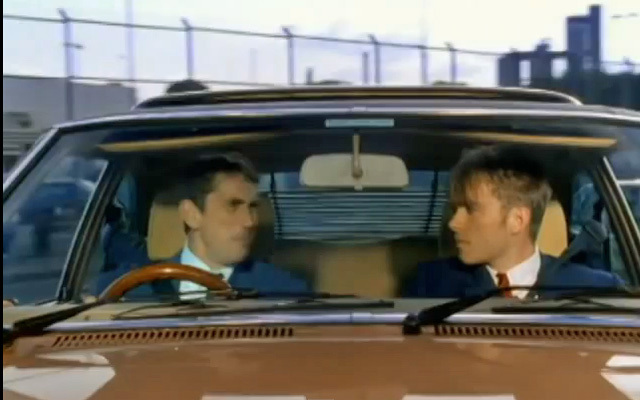

I’m a little uncertain about this, but I think this is Boord Street – the yard behind used to be for school buses. Again, you can see Tunnel Refineries in the background.


This is River Way once again – and a reminder that for most of the 1990s, One Canada Square at Canary Wharf stood alone as the only Docklands skyscraper.


Looking down River Way towards the Pilot. You can see how the street curved slightly, this was to pass underneath the gas works’ old railway line, which vanished in the 1980s.
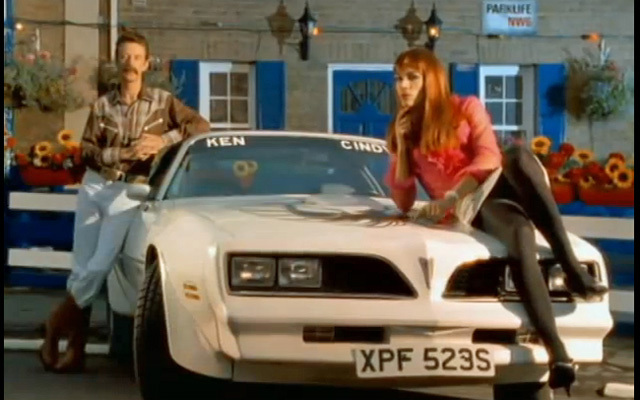

This was the old front beer garden of the Pilot, in the curve of River Way.


And one last shot – this is Dreadnought Street, which used to come off the Blackwall Tunnel approach to meet Blackwall Lane. If you got the 108 bus from east London, you’d come out of the tunnel and travel down this road. Most of it was ripped up in the 90s and a bigger slip road was installed – the recent picture is facing the other way towards that slip road.
The Parklife video isn’t Blur’s only connection with this part of south-east London. The band met at Goldsmiths College, and Alex James’s book Bit Of A Blur: The Autobiographydocuments his time living in a squat on the New Cross Road.
Back in the 1990s, east Greenwich’s derelict sites were favoured spot for videos and photoshoots – a Kylie video was shot at Lovell’s Wharf; while a few bands used Anchor Iron Wharf, which used to be an old scrapyard between the Cutty Sark pub and Greenwich Power station.
But Parklife’s the most enduring reminder, and it was all 20 years ago today. Where did the time go, eh?

Greenwich pocket park threatened by council sale plan

“Pocket park” is an abused term, but the idea is that it’s a small open space looked after by the local community. It’s something that’s been championed by City Hall under Boris Johnson’s administration, and it’s been apparently been used to fund 100 projects across the capital.
As ever, it doesn’t appear that Greenwich Council has got involved in this scheme. But a good example would be the little patch of green at the Blackwall Lane/ Tunnel Avenue junction in east Greenwich.

I’m guessing it probably dates back to the construction of the Blackwall Tunnel approach in the late 1960s. It’s almost a village green for this overlooked corner of SE10, helping soak up the high pollution levels and offsetting the effect of the ugly flats going up next door.
Overshadowed in recent years by a large ad hoarding, the green’s been looked after by council staff – not from the parks department, I gather, but from the Cleansweep streets operation. There’s potential here – but instead, the council wants to get rid of this little space…

Buried in back of this week’s edition of council propaganda sheet Greenwich Time is this public notice, stating the authority’s intention to sell the space. Presumably it thinks it’ll be attractive to property developers – even though the green itself is about the only appealling thing in this area.
In recent years, Greenwich has used spare plots of land for council housing – including wiping out a small green space on the borough boundary at Hambledown Road in Sidcup. But at least that land went to some public good – here, the council, which recently announced it has reserves of £1.2 billion, just wants to flog it and cash in.
And despite protestations that this is a “new era” of openness for the council, the first anyone knew of the plan was by looking at the back of Greenwich Time.
There are ways to fight this – getting it declared a village green, or an asset of community value – although these don’t offer much protection when it’s the council itself is the wrecking party. I wonder what the three new Peninsula ward councillors think of what’s being done in their name?
